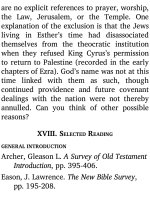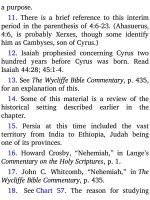Jensens survey of the old testament adam 601
Bạn đang xem bản rút gọn của tài liệu. Xem và tải ngay bản đầy đủ của tài liệu tại đây (177.36 KB, 4 trang )
19, 24; 4:13, 16 (“we have come to know”);
5:15, 18, 19, 20.
9. Two of the grandest statements of the
epistle are “God is light” (1:5) and “God is
love” (4:8, 16). See how these two themes
are referred to throughout the book.
10. Observe where and how John refers to
false teaching in his epistle.
C. STRUCTURE OF 1 JOHN
1. Compare the opening paragraph (1:1-4)
with the concluding one (5:18-21). For
example, note in their context such similar
terms as “eternal life.”
2. Various attempts have been made to
outline this epistle.9 Most students of this
book agree that an outline is not too obvious
because John’s approach is not logical and
argumentative but contemplative. Having
stated his theme in the opening paragraph
(1:1-4), John proceeds to support the theme
in various ways, item added to item, until he
arrives at the conclusion of his letter (5:1321).
Although an outline, as such, is di cult to
detect in the core of the epistle (1:5—5:12),
one cannot help but feel that John reaches a
turning point at 3:1, where he wants to
pursue the subject of fellow-ship from a
slightly di erent vantage point. Read
chapter 2 again, and then read 3:1 ., to see
if there appears to you to be a turning point
at 3:1. See Chart 116, which shows the
epistle built around this turning point.
CHART 116: 1 JOHN: FELLOWSHIP WITH GOD
AND WITH HIS CHILDREN
3. Note the outline on fellowship shown on
the chart. This may suggest outlines on
other subjects, which you will want to
develop in this survey study. For example,
try making an outline on the subject, “What
the Christian Life Is.”10
4. Observe near the top of Chart 116 the
two statements God is light and God is love.
Locate each in the text of the epistle. Then
go through the epistle paragraph by
paragraph and see how its two main parts
(1:5—2:29 and 3:1—4:21) are represented
by those two statements.
5. Study the other parts of Chart 116 if
you have not already done so. Read the
Bible text to observe how the last two
segments (5:1-12 and 5:13-21) focus on the
key words “believe” and “know.”
6. Note the key words shown at the
bottom of Chart 116. Add to the list other
words and phrases that you may have
observed in your study so far.
V. PROMINENT SUBJECTS OF 1 JOHN
A. FELLOWSHIP (1:1—2:2)
1 . Persons of the fellowship. The center of
John’s message is not a theological system
or religious creed, but a person — Jesus
Christ. He is the one whom John writes
about first (1:1 ff.).









